Ming Yin
University of California Santa Barbara
Assessing Automated Fact-Checking for Medical LLM Responses with Knowledge Graphs
Nov 16, 2025Abstract:The recent proliferation of large language models (LLMs) holds the potential to revolutionize healthcare, with strong capabilities in diverse medical tasks. Yet, deploying LLMs in high-stakes healthcare settings requires rigorous verification and validation to understand any potential harm. This paper investigates the reliability and viability of using medical knowledge graphs (KGs) for the automated factuality evaluation of LLM-generated responses. To ground this investigation, we introduce FAITH, a framework designed to systematically probe the strengths and limitations of this KG-based approach. FAITH operates without reference answers by decomposing responses into atomic claims, linking them to a medical KG, and scoring them based on evidence paths. Experiments on diverse medical tasks with human subjective evaluations demonstrate that KG-grounded evaluation achieves considerably higher correlations with clinician judgments and can effectively distinguish LLMs with varying capabilities. It is also robust to textual variances. The inherent explainability of its scoring can further help users understand and mitigate the limitations of current LLMs. We conclude that while limitations exist, leveraging KGs is a prominent direction for automated factuality assessment in healthcare.
MMTok: Multimodal Coverage Maximization for Efficient Inference of VLMs
Aug 25, 2025Abstract:Vision-Language Models (VLMs) demonstrate impressive performance in understanding visual content with language instruction by converting visual input to vision tokens. However, redundancy in vision tokens results in the degenerated inference efficiency of VLMs. While many algorithms have been proposed to reduce the number of vision tokens, most of them apply only unimodal information (i.e., vision/text) for pruning and ignore the inherent multimodal property of vision-language tasks. Moreover, it lacks a generic criterion that can be applied to different modalities. To mitigate this limitation, in this work, we propose to leverage both vision and text tokens to select informative vision tokens by the criterion of coverage. We first formulate the subset selection problem as a maximum coverage problem. Afterward, a subset of vision tokens is optimized to cover the text tokens and the original set of vision tokens, simultaneously. Finally, a VLM agent can be adopted to further improve the quality of text tokens for guiding vision pruning. The proposed method MMTok is extensively evaluated on benchmark datasets with different VLMs. The comparison illustrates that vision and text information are complementary, and combining multimodal information can surpass the unimodal baseline with a clear margin. Moreover, under the maximum coverage criterion on the POPE dataset, our method achieves a 1.87x speedup while maintaining 98.7% of the original performance on LLaVA-NeXT-13B. Furthermore, with only four vision tokens, it still preserves 87.7% of the original performance on LLaVA-1.5-7B. These results highlight the effectiveness of coverage in token selection.
Complex Logical Instruction Generation
Aug 12, 2025Abstract:Instruction following has catalyzed the recent era of Large Language Models (LLMs) and is the foundational skill underpinning more advanced capabilities such as reasoning and agentic behaviors. As tasks grow more challenging, the logic structures embedded in natural language instructions becomes increasingly intricate. However, how well LLMs perform on such logic-rich instructions remains under-explored. We propose LogicIFGen and LogicIFEval. LogicIFGen is a scalable, automated framework for generating verifiable instructions from code functions, which can naturally express rich logic such as conditionals, nesting, recursion, and function calls. We further curate a collection of complex code functions and use LogicIFGen to construct LogicIFEval, a benchmark comprising 426 verifiable logic-rich instructions. Our experiments demonstrate that current state-of-the-art LLMs still struggle to correctly follow the instructions in LogicIFEval. Most LLMs can only follow fewer than 60% of the instructions, revealing significant deficiencies in the instruction-following ability. Code and Benchmark: https://github.com/mianzhang/LogicIF
Genome-Bench: A Scientific Reasoning Benchmark from Real-World Expert Discussions
May 26, 2025Abstract:In this short report, we present an automated pipeline tailored for the genomics domain and introduce \textit{Genome-Bench}, a new benchmark constructed from over a decade of scientific forum discussions on genome engineering. Our pipeline transforms raw interactions into a reinforcement learning friendly multiple-choice questions format, supported by 3000+ high quality question answer pairs spanning foundational biology, experimental troubleshooting, tool usage, and beyond. To our knowledge, this is the first end-to-end pipeline for teaching LLMs to reason from scientific discussions, with promising potential for generalization across scientific domains beyond biology.
Which Agent Causes Task Failures and When? On Automated Failure Attribution of LLM Multi-Agent Systems
Apr 30, 2025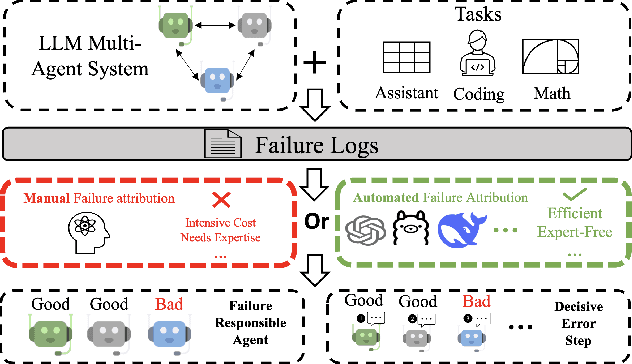
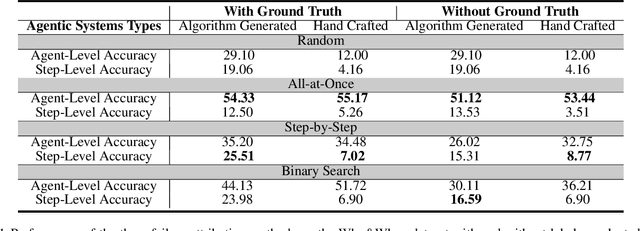

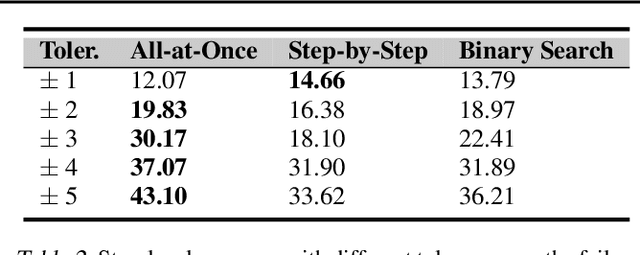
Abstract:Failure attribution in LLM multi-agent systems-identifying the agent and step responsible for task failures-provides crucial clues for systems debugging but remains underexplored and labor-intensive. In this paper, we propose and formulate a new research area: automated failure attribution for LLM multi-agent systems. To support this initiative, we introduce the Who&When dataset, comprising extensive failure logs from 127 LLM multi-agent systems with fine-grained annotations linking failures to specific agents and decisive error steps. Using the Who&When, we develop and evaluate three automated failure attribution methods, summarizing their corresponding pros and cons. The best method achieves 53.5% accuracy in identifying failure-responsible agents but only 14.2% in pinpointing failure steps, with some methods performing below random. Even SOTA reasoning models, such as OpenAI o1 and DeepSeek R1, fail to achieve practical usability. These results highlight the task's complexity and the need for further research in this area. Code and dataset are available at https://github.com/mingyin1/Agents_Failure_Attribution
Keyframe-oriented Vision Token Pruning: Enhancing Efficiency of Large Vision Language Models on Long-Form Video Processing
Mar 13, 2025Abstract:Vision language models (VLMs) demonstrate strong capabilities in jointly processing visual and textual data. However, they often incur substantial computational overhead due to redundant visual information, particularly in long-form video scenarios. Existing approaches predominantly focus on either vision token pruning, which may overlook spatio-temporal dependencies, or keyframe selection, which identifies informative frames but discards others, thus disrupting contextual continuity. In this work, we propose KVTP (Keyframe-oriented Vision Token Pruning), a novel framework that overcomes the drawbacks of token pruning and keyframe selection. By adaptively assigning pruning rates based on frame relevance to the query, KVTP effectively retains essential contextual information while significantly reducing redundant computation. To thoroughly evaluate the long-form video understanding capacities of VLMs, we curated and reorganized subsets from VideoMME, EgoSchema, and NextQA into a unified benchmark named SparseKV-QA that highlights real-world scenarios with sparse but crucial events. Our experiments with VLMs of various scales show that KVTP can reduce token usage by 80% without compromising spatiotemporal and contextual consistency, significantly cutting computation while maintaining the performance. These results demonstrate our approach's effectiveness in efficient long-video processing, facilitating more scalable VLM deployment.
From Text to Trust: Empowering AI-assisted Decision Making with Adaptive LLM-powered Analysis
Feb 17, 2025Abstract:AI-assisted decision making becomes increasingly prevalent, yet individuals often fail to utilize AI-based decision aids appropriately especially when the AI explanations are absent, potentially as they do not %understand reflect on AI's decision recommendations critically. Large language models (LLMs), with their exceptional conversational and analytical capabilities, present great opportunities to enhance AI-assisted decision making in the absence of AI explanations by providing natural-language-based analysis of AI's decision recommendation, e.g., how each feature of a decision making task might contribute to the AI recommendation. In this paper, via a randomized experiment, we first show that presenting LLM-powered analysis of each task feature, either sequentially or concurrently, does not significantly improve people's AI-assisted decision performance. To enable decision makers to better leverage LLM-powered analysis, we then propose an algorithmic framework to characterize the effects of LLM-powered analysis on human decisions and dynamically decide which analysis to present. Our evaluation with human subjects shows that this approach effectively improves decision makers' appropriate reliance on AI in AI-assisted decision making.
MATH-Perturb: Benchmarking LLMs' Math Reasoning Abilities against Hard Perturbations
Feb 10, 2025



Abstract:Large language models have demonstrated impressive performance on challenging mathematical reasoning tasks, which has triggered the discussion of whether the performance is achieved by true reasoning capability or memorization. To investigate this question, prior work has constructed mathematical benchmarks when questions undergo simple perturbations -- modifications that still preserve the underlying reasoning patterns of the solutions. However, no work has explored hard perturbations, which fundamentally change the nature of the problem so that the original solution steps do not apply. To bridge the gap, we construct MATH-P-Simple and MATH-P-Hard via simple perturbation and hard perturbation, respectively. Each consists of 279 perturbed math problems derived from level-5 (hardest) problems in the MATH dataset (Hendrycksmath et. al., 2021). We observe significant performance drops on MATH-P-Hard across various models, including o1-mini (-16.49%) and gemini-2.0-flash-thinking (-12.9%). We also raise concerns about a novel form of memorization where models blindly apply learned problem-solving skills without assessing their applicability to modified contexts. This issue is amplified when using original problems for in-context learning. We call for research efforts to address this challenge, which is critical for developing more robust and reliable reasoning models.
No-Regret Linear Bandits under Gap-Adjusted Misspecification
Jan 09, 2025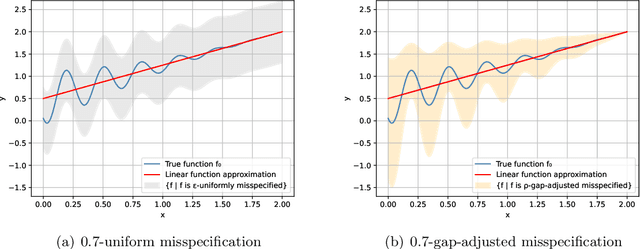
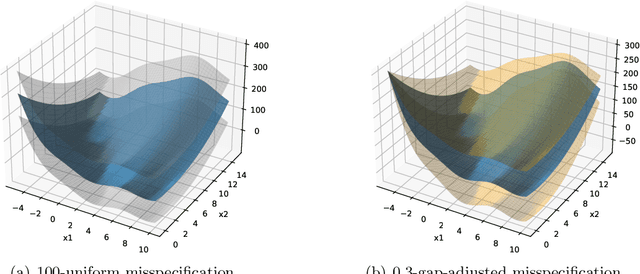
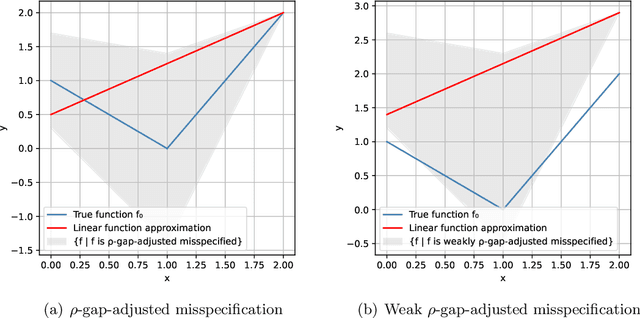
Abstract:This work studies linear bandits under a new notion of gap-adjusted misspecification and is an extension of Liu et al. (2023). When the underlying reward function is not linear, existing linear bandits work usually relies on a uniform misspecification parameter $\epsilon$ that measures the sup-norm error of the best linear approximation. This results in an unavoidable linear regret whenever $\epsilon > 0$. We propose a more natural model of misspecification which only requires the approximation error at each input $x$ to be proportional to the suboptimality gap at $x$. It captures the intuition that, for optimization problems, near-optimal regions should matter more and we can tolerate larger approximation errors in suboptimal regions. Quite surprisingly, we show that the classical LinUCB algorithm -- designed for the realizable case -- is automatically robust against such $\rho$-gap-adjusted misspecification with parameter $\rho$ diminishing at $O(1/(d \sqrt{\log T}))$. It achieves a near-optimal $O(\sqrt{T})$ regret for problems that the best-known regret is almost linear in time horizon $T$. We further advance this frontier by presenting a novel phased elimination-based algorithm whose gap-adjusted misspecification parameter $\rho = O(1/\sqrt{d})$ does not scale with $T$. This algorithm attains optimal $O(\sqrt{T})$ regret and is deployment-efficient, requiring only $\log T$ batches of exploration. It also enjoys an adaptive $O(\log T)$ regret when a constant suboptimality gap exists. Technically, our proof relies on a novel self-bounding argument that bounds the part of the regret due to misspecification by the regret itself, and a new inductive lemma that limits the misspecification error within the suboptimality gap for all valid actions in each batch selected by G-optimal design.
On the Statistical Complexity for Offline and Low-Adaptive Reinforcement Learning with Structures
Jan 03, 2025



Abstract:This article reviews the recent advances on the statistical foundation of reinforcement learning (RL) in the offline and low-adaptive settings. We will start by arguing why offline RL is the appropriate model for almost any real-life ML problems, even if they have nothing to do with the recent AI breakthroughs that use RL. Then we will zoom into two fundamental problems of offline RL: offline policy evaluation (OPE) and offline policy learning (OPL). It may be surprising to people that tight bounds for these problems were not known even for tabular and linear cases until recently. We delineate the differences between worst-case minimax bounds and instance-dependent bounds. We also cover key algorithmic ideas and proof techniques behind near-optimal instance-dependent methods in OPE and OPL. Finally, we discuss the limitations of offline RL and review a burgeoning problem of \emph{low-adaptive exploration} which addresses these limitations by providing a sweet middle ground between offline and online RL.
 Add to Chrome
Add to Chrome Add to Firefox
Add to Firefox Add to Edge
Add to Edge